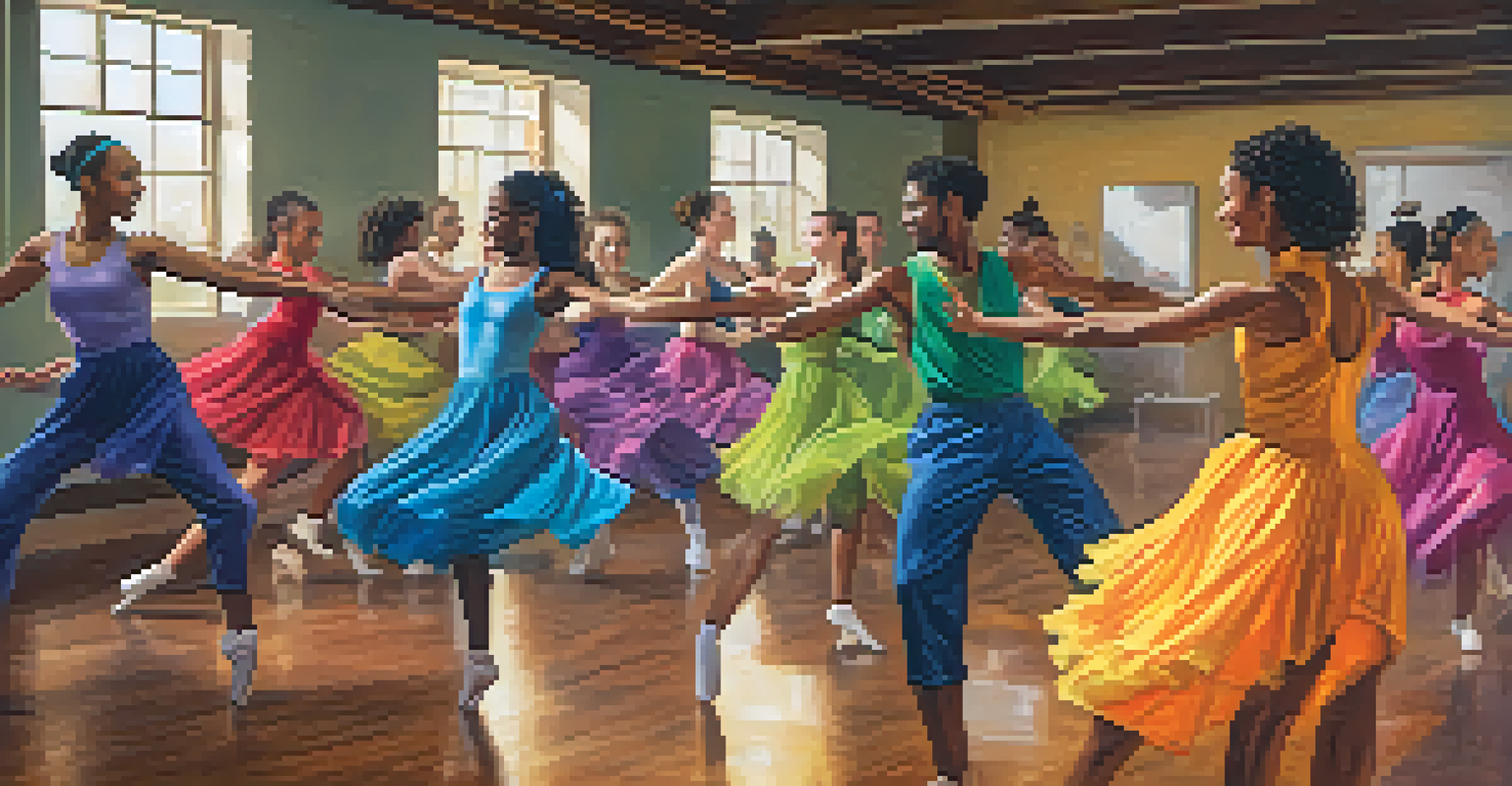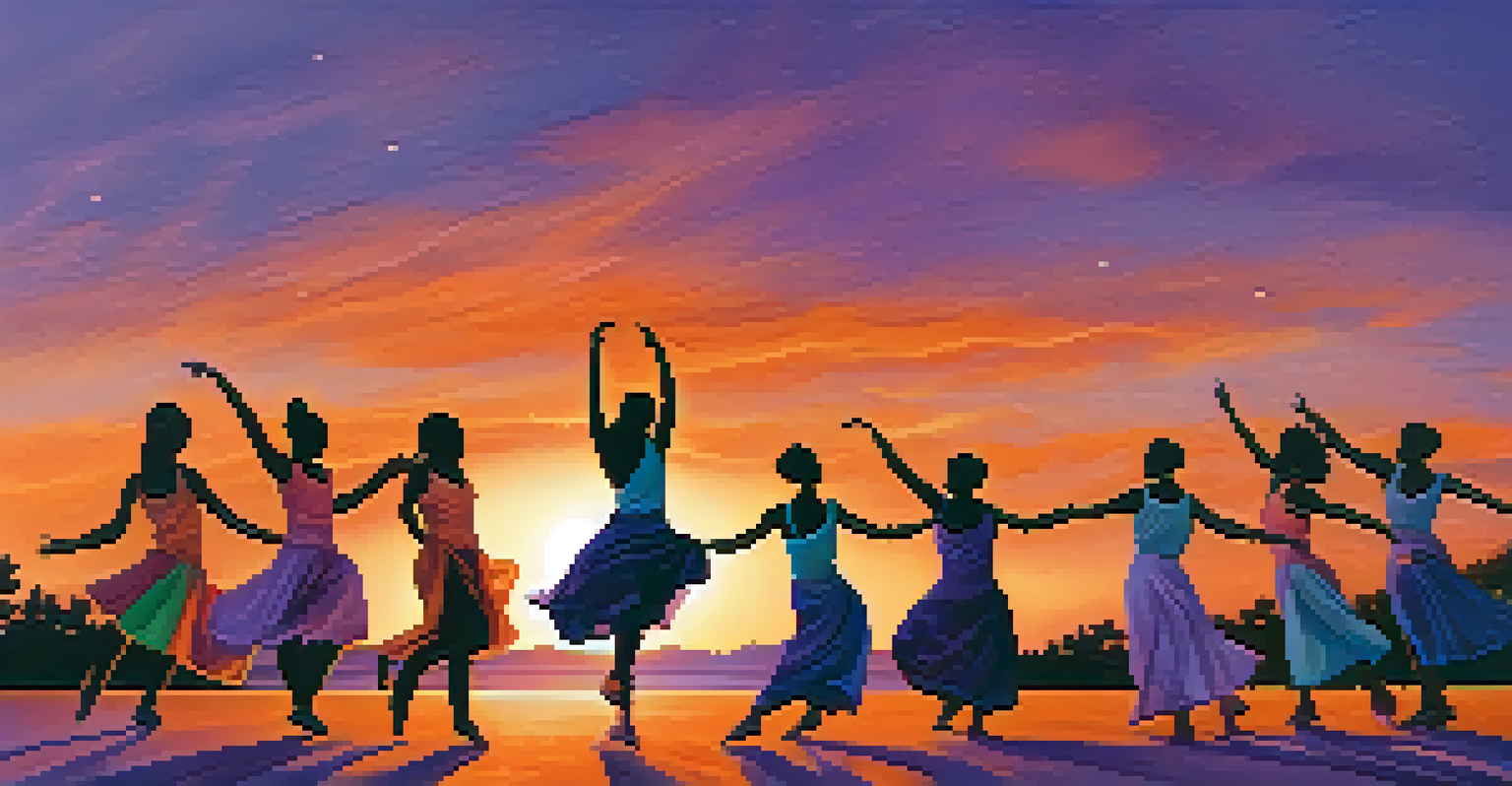How Dance Enhances Personal Growth and Self-Discovery

Dance as a Pathway to Self-Expression
Dance offers a unique avenue for individuals to express their emotions and thoughts without the need for words. Every movement can tell a story, allowing dancers to convey feelings that might be difficult to articulate. This form of expression not only promotes emotional release but also fosters a sense of identity, as dancers learn to embrace their unique styles and narratives.
Dance is the hidden language of the soul.
When you step onto the dance floor, it's like stepping into a world where you can be your true self. You can let go of societal expectations and simply move as you feel. This freedom encourages individuals to explore their inner selves and discover parts of their personality they may not have acknowledged before.
Moreover, the act of dancing often invites creativity into our lives. Whether it’s a structured routine or an improvised movement, each dance session becomes a canvas for creative expression, enhancing self-discovery through exploration and originality.
Building Confidence Through Movement
The journey of learning and mastering dance can significantly boost self-confidence. Each new step or routine achieved is a tangible accomplishment, reminding dancers of their capabilities. As they become more comfortable with their bodies and movements, they often find themselves feeling more assured in other aspects of life as well.

Moreover, dancing in front of others, whether in classes or performances, challenges individuals to overcome fears of judgment. This bravery in facing an audience translates into greater self-assurance off the dance floor, allowing individuals to take risks and embrace new challenges.
Dance as Emotional Expression
Dance allows individuals to express complex emotions and foster a sense of identity through movement.
As they gain confidence, many dancers also discover a newfound appreciation for their bodies. They learn to celebrate their physical abilities rather than criticize perceived flaws, fostering a positive body image that can extend far beyond dance.
Cultivating Emotional Awareness and Intelligence
Dance is not just about physical movement; it's also deeply connected to our emotions. Engaging in dance encourages individuals to tap into their feelings, fostering emotional awareness. This heightened sensitivity can lead to a better understanding of one’s emotional state, helping dancers learn how to express and manage their emotions effectively.
The dance is a poem of which each movement is a word.
Through various dance styles, individuals often explore a range of emotions—from joy and excitement to sadness and frustration. This exploration can be therapeutic, providing a safe space to process complex feelings, which is essential in personal growth.
Additionally, as dancers become more in tune with their own emotions, they often cultivate empathy towards others. Understanding one's feelings can lead to a deeper connection with others, enhancing interpersonal relationships and fostering a supportive community.
Creating Community and Connection
One of the most beautiful aspects of dance is its ability to bring people together. Whether in a dance class, a social dance event, or a performance, individuals share a common passion that fosters camaraderie and connection. This sense of community can be incredibly supportive, providing a network of friends who encourage each other's growth.
Moreover, dancing with others teaches valuable social skills, such as teamwork and communication. Learning to collaborate in partner dances or group routines helps individuals navigate social dynamics, building their confidence in various social settings.
Building Confidence Through Dance
Mastering dance boosts self-confidence and encourages a positive body image, enhancing personal growth.
These connections often extend beyond dance, leading to friendships and support systems that enrich personal lives. The shared experiences in dance create bonds that can help individuals feel less isolated in their journeys of self-discovery.
Developing Discipline and Resilience
Dance requires practice, patience, and perseverance, qualities that are essential for personal growth. The discipline developed through regular practice can translate into other areas of life, helping individuals to set and achieve goals effectively. As dancers work towards mastering techniques or routines, they learn the value of hard work and dedication.
Along the way, dancers also face challenges and setbacks, whether it's struggling with a difficult move or coping with performance anxiety. Overcoming these obstacles builds resilience, teaching individuals that failure is a part of the journey and not an endpoint.
This mindset of resilience is invaluable, as it encourages individuals to keep pushing forward, even when faced with difficulties. The lessons learned on the dance floor can empower individuals to tackle challenges in their personal and professional lives with a renewed sense of determination.
Exploring Creativity and Innovation
Dance is an art form that thrives on creativity and innovation. Engaging in dance encourages individuals to think outside the box, fostering an environment where experimentation is welcomed. This creative exploration can lead to personal breakthroughs, unlocking new ways of thinking and problem-solving in everyday life.
When individuals create their own choreography or interpret existing dances in their unique way, they learn to trust their instincts and creative impulses. This process can ignite a spark of inspiration that transcends the dance floor, influencing other creative pursuits such as writing, painting, or even cooking.
Creating Community Through Movement
Dance fosters connections and friendships, creating a supportive community that enriches personal journeys.
Furthermore, the freedom to express oneself through dance can lead to a greater appreciation for individuality. Dancers learn that there are no right or wrong ways to express themselves, allowing them to embrace their quirks and uniqueness, which is a vital part of personal growth.
Embracing Lifelong Learning and Growth
Dance is a journey, and like any journey, it offers continuous opportunities for learning and growth. Whether it's mastering a new style, learning from a teacher, or joining a dance community, each experience contributes to personal development. This commitment to lifelong learning is essential for personal growth, as it encourages individuals to remain curious and open-minded.
As dancers progress in their skills, they often find new interests and passions that can enhance their lives. This ongoing exploration not only enriches their dance experience but also opens doors to new social circles, hobbies, and career opportunities.

Moreover, embracing the mindset of continuous improvement can lead to a fulfilling life. Individuals learn to celebrate small victories and see challenges as opportunities for growth, nurturing a positive outlook that supports overall well-being.